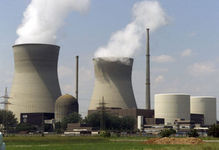 Germany has announced that it will shut down all of its nuclear power plants by 2022. The country has already suspended operations at seven of its oldest nuclear power plants following the disaster at Fukushima in Japan. Those seven plants will now remain offline permanently. Six more nuclear plants will be shut down by 2021, and the remaining three plants will be shut down by 2022.
The German government says that this decision advances four priorities: Germany's standing as a top global economy, an affordable and sufficient energy supply, climate protection, and independence from energy imports. It appears, however, that the real impetus for the decision was political. Large portions of the German public wanted to abandon nuclear power after Chernobyl, as Italy did, and the latest nuclear disaster in Japan pushed public opinion over the brink.
The big question is: How will the fourth largest economy in the world meet its power needs without nuclear power plants?
Nuclear power supplies 23% of Germany's electricity today. Even assuming zero growth in demand for electricity over the next 10 years, replacing almost a quarter of the German electricity supply will not be easy . . . or cheap. Renewables such as solar and wind supply only 17% of German electricity today, and that has been achieved only with extensive and expensive government subsidies. Replacing nuclear power with renewables will require not only more investments in renewable generation, but also investments in a smarter grid and storage to match these intermittent sources with demand.
Keep in mind that tripling the amount of electricity generated from renewable sources over the next 10 years will only replace the electricity lost from nuclear plants. It will do nothing to reduce the 60% of electricity that now comes from coal, natural gas, and other fossil fuels. And if Germany is unsuccessful in replacing nuclear with renewables, it will be forced to replace nuclear with dirty fossil fuels.
Proponents of shutting down the nuclear power plants say that Germany can do it all. They claim that greater efficiencies will not only stop the growth of electricity consumption, but will actually reduce consumption by 10% over the next 10 years. They claim that new investments in renewable generation, storage, and a smarter grid will create jobs and make Germany a world leader in important new industries. And that a decade from now, Germany will have a competitive advantage because half or more of its electricity will come from renewable sources that have zero ongoing fuel costs.
I hope they succeed.
John Howley
Woodbridge, New Jersey
 New Jersey Governor Chris Christie tried to take all sides of the climate change debate yesterday by acknowledging that climate change is real, agreeing that human activity contributes to it, and then withdrawing New Jersey from the Regional Greenhouse Gas Initiative (RGGI) that tries to reduce it. He argued that RGGI imposes unnecessary costs on consumers, but when pressed to quantify how much consumers will save by his actions, the Governor conceded that consumers should not expect much in the way of savings. Huh?Under RGGI, 10 Northeastern and mid-Atlantic states have agreed to require power plants that burn fossil fuels to buy pollution allowances for their carbon emissions. Utilities that cut their emissions below a specified cap may sell or trade their excess carbon allowances in online auctions held four times a year. Proceeds from the auctions -- about $860 million so far -- can be used to finance renewable energy initiatives. The program has provided $29.6 million for 12 large-scale energy efficiency and renewable energy projects in New Jersey alone. Governor Christie acknowledged that humans are causing climate change. “I’ve always said that climate change is real and it’s impacting our state,” he said. But the Governor said that RGGI is not an effective solution. He asserted that New Jersey is reducing emissions by using more natural gas and less coal to generate electricity, not because of RGGI. He also said that he opposed building any new coal-fired power plants in New Jersey. The nine other states that remain in RGGI reiterated their support for the program in the wake of Governor Christie';s decision. New York State officials called the initiative “extremely successful” in reducing greenhouse gas emissions and helping finance clean energy projects. The Commissioner of the New York Department of Environmental Conservation issued a statement that “investment of RGGI auction proceeds in energy efficiency improvements is leading to savings for thousands of New York residents and businesses and to the creation of thousands of high-quality jobs.” Governor Christie's main argument against RGGI is that it imposes unnecessary costs on consumers. "RGGI," the Governor said, "does nothing more than tax electricity, tax our citizens, tax our businesses, with no discernible or measurable impact upon our environment.” But w hen Governor Christie was asked how much consumers could expect to save as a result of his decision to withdraw from RGGI, he replied, "I don’t want to overplay that because we’re not talking about a huge difference." Huh?John Howley Woodbridge, New Jersey
President Obama has directed federal agencies to buy alternative fuel cars and light-duty trucks, with the objective of buying only alternative fuel vehicles by 2015. The Obama Administration launched this initiative by leasing more than 100 electric vehicles. Energy Secretary Steven Chu said this initiative will help meet the President's goal of putting 1 million alternative fuel vehicles on the road by 2015 and a 30% reduction in the US government's dependence on petroleum by 2020. This is not the first time the US Government has attempted to initiate demand for alternative fuel vehicles by mandating purchases by government agencies. The first Energy Policy Acts (EPAct) of 1992 and 2005 require federal fleets with 20 or more vehicles to lease or purchase alternative fuel vehicles for at least 75 percent of all new light-duty vehicle acquisitions, and to use only alternative fuel in such vehicles unless granted a waiver. Executive Order 13423, signed by President George W. Bush in January 2007, added the requirements that federal agencies also: (1) increase overall alternative fuel use by 10 percent annually; (2) reduce petroleum consumption by 2 percent annually through 2015; and (3) purchase plug-in hybrid electric vehicles when available at a reasonable cost. The US Government Accountability Office (GAO) found that federal agencies had mixed results in meeting these existing mandates in in fiscal year 2007. While all the agencies met or exceeded the requirement to acquire alternative fuel vehicles, they did so by including vehicles that were not subject to the requirement. The GAO also found that neither the Department of Energy nor the other individual agencies reported their compliance with the requirement that they use only alternative fuels in such vehicles, even though they are required by law to make such reports. In fact, the GAO found that in fiscal year 2006, most agencies fueled their alternative fuel vehicles with 100% gasoline, and the GAO found no evidence that this practice had changed in fiscal year 2007. The GAO was not able to confirm assertions by many agencies that they had met the objectives of increasing their alternative fuel use by 10 percent and reducing their petroleum use by 2%. According to the GAO, "persistent data problems call these results into question." In addition, the GAO noted that it will be difficult for agencies to meet these objectives because of the limited availability of alternative fuels in some markets. Lastly, not a single federal agency acquired plug-in hybrid electric vehicles during fiscal year 2007 for the simple reason that they were not commercially available. The Obama Administration is working to improve execution on the existing and new federal mandates. Last year, the General Service Administration (GSA) doubled the size of the federal hybrid fleet, helping the government reduce its petroleum consumption by 385,000 barrels per year. In the announcement earlier this week, the GSA promised to coordinate with federal agencies to establish fueling and recharging stations the new fleets will require. John HowleyWoodbridge, New Jersey
New wind power generation in the US grew 40% per year from 2005 to 2009, far outpacing new electricity generation from natural gas or coal. But increasing supplies of natural gas are driving down prices, causing private equity investors to shift their focus away from wind power and into natural gas-fired power plants instead. Last year, in 2010, the US added only 3,657 megawatts (MW) of new wind generation capacity, down from 9,645 MW of new capacity in 2009. In contrast, natural gas-fired capacity grew by 6,309 MW and even coal-fired capacity grew by 5,217 MW. Construction of new wind power generation is expected to drop again this year because of competition from cheap natural gas. In addition to price competition from natural gas, wind also faces the challenge of uncertainty over the future of renewable energy tax credits given the current budget debates in Congress and the continuing weak economy. Wind still has a few things going for it. Many states have renewable energy mandates that require utilities to acquire a certain percentage of their electricity from renewable sources. Wind remains one of the most cost-effective ways to comply with those mandates. Turbine prices are also dropping which makes wind farms more competitive with natural gas. John HowleyWoodbridge, New Jersey
 My mother, the grandmother of eight grandchildren, periodically includes me when she sends around emails to her friends. Her latest missive is about an unknown grandmother accused of not living a green and sustainable life. If you can look beyond the sarcasm and hyperbole, you'll find some thought-provoking kernels of truth. Here it is:
A Grandmother's Rant About the Good, Green Ol' Days
In the line at the store, the cashier told the older woman that she should bring her own grocery bag because plastic bags weren't good for the environment. The woman apologized to him and explained, "We didn't have the green thing back in my day."
The clerk responded, "That's our problem today. The former generation did not care enough to save our environment." He was right, that generation didn't have the green thing in its day. Back then, they returned their milk bottles, soda bottles and beer bottles to the store. The store sent them back to the plant to be washed and sterilized and refilled, so it could use the same bottles over and over. So they really were recycled. But they didn't have the green thing back in that customer's day.
In her day, they walked up stairs, because they didn't have an escalator in every store and office building. They walked to the grocery store and didn't climb into a 300-horsepower machine every time they had to go two blocks. But she was right. They didn't have the green thing in her day.
Back then, they washed the baby's diapers because they didn't have the throw-away kind. They dried clothes on a line, not in an energy gobbling machine burning up 220 volts -- wind and solar power really did dry the clothes. Kids got hand-me-down clothes from their brothers or sisters, not always brand-new clothing. But that old lady is right; they didn't have the green thing back in her day.
Back then, they had one TV, or radio, in the house -- not a TV in every room. And the TV had a small screen the size of a handkerchief, not a screen the size of the state of Montana. In the kitchen, they blended and stirred by hand because they didn't have electric machines to do everything for you.
When they packaged a fragile item to send in the mail, they used a wadded up old newspaper to cushion it, not Styrofoam or plastic bubble wrap. Back then, they didn't fire up an engine and burn gasoline just to cut the lawn. They used a push mower that ran on human power. They exercised by -- this is the Honest-to-God Truth! -- working so they didn't need to go to a health club to run on treadmills that operate on electricity. But she's right; they didn't have the green thing back then.
They drank from a fountain when they were thirsty instead of using a cup or a plastic bottle every time they had a drink of water. They refilled their writing pens with ink instead of buying a new pen, and they replaced the razor blades in a razor instead of throwing away the whole razor just because the blade got dull. But they didn't have the green thing back then.
Back then, people took the streetcar or a bus and kids rode their bikes to school or rode the school bus instead of turning their moms into a 24-hour taxi service. They had one electrical outlet in a room, not an entire bank of sockets to power a dozen appliances. And they didn't need a computerized gadget to receive a signal beamed from satellites 2,000 miles out in space in order to find the nearest pizza joint.
But isn't it sad? The current generation laments how wasteful the old folks were just because they didn't have the green thing back then?
(If anyone knows the author, please let me know so I can give them appropriate recognition.)
 President Obama may have thought he was appealing to patriotic instincts, but his speech at Georgetown University sent the wrong message by promoting the fallacy that we can save our economy by driling for more "domestic oil" to reduce our dependence on "foreign oil." Webster's defines a "fallacy" as "an often plausible argument using false or invalid inference." That is exactly what our elected officials are selling us. President Obama's argument that we can reduce our dependence on foreign oil by drilling in the the Gulf is plausible, as is Republican Senator Mitch McConnell's retort that even more oil could be produced by drilling in Alaska. The false inference is that drilling for more domestic oil will somehow end the cycles of energy crises that have triggered economic recessions since the 1970's. Here are the facts:More domestic crude oil will not shield us from higher and more erratic oil prices in global markets. Most of our imported oil comes from Canada and Mexico. We do not import any meaningful quantities from Tunisia, Egypt or Libya. Yet, the oil we buy from Canada and Mexico also costs more than $100 per barrel, just like the oil from countries in turmoil. Because oil prices are set by a global market. Even if we drill for more oil in the US, the price of all our oil will be determined by OPEC, increasing demand from China and other developing countries, and instability in the Middle East. [After this post first appeared, some readers pointed out that reducing foreign oil imports will help reduce the balance of trade deficit. True, but getting there by producing more domestic crude is not the solution, for reasons explained below.] More domestic crude oil will not decrease environmental harms. Whether we burn domestic or foreign oil, the impact on the environment is the same. Indeed, more drilling in the US will result in more environmental harms, not less. Remember that the BP Deepwater Horizon and the Exxon Valdez catastrophes were the direct result of domestic oil production. Expect even more of these types of disasters as domestic oil production expands into environmentally sensitive areas, especially when the multinational oil industry wraps itself in our flag and argues for more lenient regulations in the name of reducing our dependence on "foreign" oil. More domestic crude oil will not increase the supply of domestic gasoline, diesel, or other refined products. Our US refineries have been operating at 85% to 90% capacity throughout the Great Recession. This is very close to full capacity because refineries must shut down periodically for maintenance and safety reasons. That is why nearly 25% of our oil imports are in the form of refined products. We do not have the capacity in the US to refine more crude oil into useful products. Even if we produce more oil from domestic sources to replace "foreign oil," that will not result in more refined products in the US market. As the economy recovers and demand increases, we will need to import even more refined products from foreign countries. More domestic crude oil will not make us more competitive with China, India, and Europe. Markets in the rest of the world are shifting to sustainable energy. Germany is getting almost 20% of its energy from renewable sources right now. GE just bought a French technology company and anticipates creating large numbers of renewable energy jobs in Europe where government policies favor sustainable energy. China is outpacing us in sustainable energy investments. In the short run, these countries are creating new jobs in new industries. In the long run, they will have less expensive sources of energy. President Obama's embrace of more domestic oil production as the solution to "foreign oil" is tragic on many levels. It resulted in news headlines that distracted citizens from many other initiatives that he has promoted to wean the US from oil, domestic or foreign. It weakened him politically by damping the enthusiasm of environmentalists and others on the left who are his natural base, while emboldening those who support dirty fuels. At the same time, he sent a confusing message to vast numbers of independent voters by suggesting that the dirty energy advocates have a legitimate argument when they say that drilling for more domestic oil is a solution. That lets his critics avoid the very tough question of how we will wean ourselves from dirty fuels. Most tragically, the President's willingness to promote domestic oil as a solution to "foreign oil" appears to represent an abandonment of the one thing that will ultimately help us move to a more sustainable energy infrastructure -- using government policy to change the economics of energy. If we really want to build a sustainable energy infrastructure, we should start by: (a) phasing out all direct and indirect government subsidies for dirty fuels over a seven-year period; and (b) including the cost of pollution and related harms to human health in the price of dirty fuels. Not only would that spur investment in clean energy technologies, but it would also reduce the government deficit and the trade deficit.
John HowleyWoodbridge, New Jersey
 It is incredible that energy policy today is a partisan issue when, just six years ago, a bipartisan consensus resulted in one of the most powerful pieces of energy efficiency legislation ever. Legislation that continues to bring down the energy intensity of the US economy. A new report by the American Council from an Energy Efficient Economy (ACEEE) analyzes the Energy Policy Act of 2005. The report is entitled Assessing the Harvest: Implementation of the Energy Efficiency Provisions in the Energy Policy Act of 2005. It concludes that this legislation expanded markets for money-saving energy-efficient products and created opportunities for continued bipartisan political action on energy efficiency in later legislation. The Energy Policy Act of 2005, signed by President George W. Bush, included manufacturer and consumer tax incentives for energy-saving technologies, minimum efficiency standards for appliances and equipment, and a variety of other provisions to encourage energy savings. It was the first major energy legislation since 1992, and began a period of bold energy efficiency legislation from 2005 to 2010. The most successful energy efficiency provisions had good timing, stakeholder engagement and education, and appropriate levels of funding. "The new homes and appliance manufacturer tax incentives, and the appliance and equipment standards have succeeded the best at transforming markets," said Rachel Gold, lead report author and a researcher at ACEEE. Other provisions, especially those with limited or nonexistent funding or where a loophole was built into the law did not fare as well. Among the lessons learned, the report notes that education and stakeholder engagement are critical to the success of energy efficiency programs. It also points out that legislation must take into account market conditions and barriers to product acceptance in order to shape effective policy. The report estimates that, in 2020, the Energy Policy Act of 2005 will still be saving enough energy to power the entire state of Tennessee for a full year at current energy use levels. This type of efficiency is essential not only to protect the environment, but to maintain a competitive economy. As energy costs increase due to a wide range of factors from growing demand from China and India to instability in the Middle East, economies with the lowest energy intensity -- amount of energy required to produce a dollar of GDP -- will have a competitive advantage.
John HowleyWoodbridge, New Jersey
 Today's Jasmine Revolutions are taking place on the 25th anniversary of the People Power Revolution that ousted the Marcos dictatorship in the Philippines. The aftermath of the Philippine revolution suggests that, in hindsight, ousting the old leaders in the Middle East will seem like the easy part. Building a new society and new institutions will likely result in at least a decade of uncertainty, power struggles, and dramatic changes in economic and strategic relationships. To those who say that the Philippines presents a much different situation than the Middle East, I agree. The Philippines was far better prepared for a transition away from dictatorship and crony capitalism. The differences raise a real concern that the Middle East is in for a long period of uncertainty and instability. This is not a good time for the US economy to be dependent on petroleum. Who's In Charge?Long before Marcos left the Philippines, a large and well-organized opposition had developed both inside and outside the country. A new leader, Corazon Aquino, was elected before Marcos was overthrown, and she was able to assume power literally on the day the dictator left. She enjoyed widespread support from the masses and elites, including the full support of the Catholic Church and key business organizations. She also was recognized immediately by the international community as the legitimate leader of the country. This did not stop powerful factions from attempting to overthrow her new government. President Aquino faced six coup attempts during her first 18 months in office. She continued to fight off coup attempts during her entire six-year term, including one in 1989 (her third year in office) when a faction within the armed forces seized control of 22 high-rise buildings in the central business district and five major military bases throughout the country. None of the countries in the Middle East will begin its post-revolution period with leaders who have the type of legitimacy and support that President Aquino enjoyed in the Philippines. In some Middle Eastern countries, there is no clear leadership of the revolution. In others, factions will fight among themselves for control or question whether new leaders have enough distance from the old regimes. It will take time before new leaders are selected and establish their legitimacy. This leaves countries in the Middle East at a much greater risk of factional infighting and counter-revolutions. Risks that could disrupt oil production and/or exports. The Power of NationalismLeaders of the Philippine revolution had extraordinarily good and close relations with the U.S. President Aquino attended high school in Philadelphia and college in New York. Fidel Ramos, her critical supporter among the military and her successor as President, studied at West Point and maintained lifelong friendships with many U.S. leaders including his West Point classmate, former U.S. Secretary of State Alexander Haig. Important leaders in the Philippine business community and legal profession studied at U.S. universities. When the People Power Revolution took place, every Filipino over the age of 50 had personal recollections of U.S. soldiers liberating their country from the brutal Japanese occupation during World War II. Some Filipino leaders knew General Douglas MacArthur personally. Nationalism, however, is a powerful force. Especially when combined with memories of U.S. support for the Marcos dictatorship and perceptions that U.S. businesses had unfairly exploited Philippine resources. A new Philippine constitution prohibited foreign involvement in key industries such as mining and gave preference to Filipinos in all matters of "the national economy and patrimony." The new Philippine Senate refused to renew leases on U.S. military bases and effectively kicked the U.S. military out of the country. If this is what happened with one of America's closest of friends and allies, we can only guess what might happen in Middle Eastern countries without such close ties or warm feelings towards Americans. Nationalism and less than favorable perceptions of the U.S. could result in very significant changes in economic and strategic relationships. The Power of Generational ShiftsThe Philippines in 1986 and the countries going through Jasmine Revolutions today have one striking similarity. Their revolutions occurred at times of shifting generations. In 1986, more than half of all Filipinos were under the age of 30. Unlike their parents and grandparents who viewed the U.S. and other Western nations with admiration and respect, these young people knew the U.S. mostly as the country that provided money and arms to support the Marcos dictatorship. They saw the U.S. leave Vietnam and the British leave Hong Kong. They saw Singapore, Vietnam, Thailand, China and other neighbors growing economically. Telling the U.S. military to leave the Philippines and reserving economic opportunities for Filipinos was a natural extension of the trends they saw personally in the region. A similar generational shift is happening now in the countries undergoing Jasmine Revolutions. More than half the people in Tunisia and Bahrain are under the age of 30. In Egypt, Libya and Oman, more than half the people are under the age of 24. In Yemen, more than half the people are under the age of 18. The greatest economic development story in these young people's lives is the rise of China, India, and Brazil to the status of major players in the global economy. In contrast, they have seen the U.S. suffer from severe economic and terrorist shocks. They have also seen the U.S. invade Iraq. Their countries' economic and strategic relationships will form against this backdrop. Lessons LearnedThe Philippines experience suggests that we will see at least a decade of uncertainty, power struggles, and dramatic changes in economic and strategic relationships in the Middle East. There may be sudden disruptions of oil production and/or exports as factions struggle to control the wealth of these nations and chart a new course. Consistent supplies of petroleum cannot be assured.John HowleyWoodbridge, New Jersey
 How much oil is at risk in the countries undergoing Jasmine Revolutions? Not much in total volumes, but more than enough to have a very significant impact on prices. To put this in perspective, let's look at how much oil the US needs on a daily basis. The US consumes about 18.7 million barrels of oil per day (bbl/day). US domestic oil production averages about 9 million bbl/day, resulting in a deficit of about 9.7 million bbl/day. Because of a number of factors, including the need to match oil grades with refinery capacity and end uses, however, the US imports about 11.7 million bbl/day. In other words, the US imports more than 50% of the oil it consumes. Now we could start breaking down our imports into reliable and less reliable suppliers Canda and Mexio, for example, supply about 30% of US oil imports. That sounds relatively safe. But that would miss the point. Once you start importing oil, you are in a global oil market where changes in supply and/or demand in even one country can have an impact on the price Americans must pay for oil imports.The country that is causing the most concern about oil prices right now is Libya. Ranked 18th in world oil production, Libya produces about 1.79 million bbl/day and exports about 1.5 million bbl/day. The other countries in the midst of Jasmine Revolutions are even smaller producers. Oman is ranked 25th with production of 816,000 bbl/day. Egypt is ranked 29th with 680,000 bbl/day. Yemen is ranked 37th with 288,000 bbl/day. Tunisia is ranked 54th with 91,000 bbl/day. Bahrain is ranked 63rd with 49,000 bbl/day. The US imports only about 79,000 bbl/day from Libya, less than a rounding error when you consider how much oil the US imports every day, so you might be tempted to think problems in Libya won't have much of an impact on US prices. But you would be wrong. If Libyan oil exports to Europe were disrupted, the Europeans would have to find oil someplace else. That would drive up the price of the 11.7 million bbl/day that the US must import from world markets. We also have to consider the particular grade of oil. Libyan oil is known as sweet crude because of its low sulfur content. This is, in layman's terms, a premium product because you get much more gasoline, diesel, and kerosene from sweet crude than from sour crude. A loss of sweet crude simply cannot be made up with an equal amount of sour crude.There is some good news. Libya requires revenues from oil exports to function. Oil exports account for about 45% of Libya's Gross Domestic Product (GDP). In the long run, regardless of who runs that country, they will have a very big incentive to keep the oil flowing. In the short run, OPEC probably has enough spare capacity to get us through any short-term disruptions. At least as long as the global economy continues to recover from a recession. But if demand picks up shar How much will OPEC allow the price to rise? Tough to say with any precision. We know what happens if oil goes into the $140 per barrel range. The last time that happened, it triggered the Great Recession. We also know that the economy seems to tolerate prices at $90 to $100 per barrel without going into a tailspin. The consensus view among analysts seems to be that prices at or above $100 per barrel may be the new normal. With the very real possibility of prices at the $120 per barrel level if OPEC sees a need to tamp down demand or if markets get jittery in response to events in Libya or elsewhere.So how much oil is at risk? The answer is: More than enough that we should be concerned. John HowleyWoodbridge, New Jersey
 Warren Buffett explains the root of his success as acting rationally about capital allocation over the long term. Our elected officials would be wise to take note of this investment advice when building a budget. By focusing on where to allocate our society's capital over the long term, we can make wiser decisions.
Start with education. In the 20th century, America allocated more capital to education than any other country in the world. This investment gave us the most highly educated and innovative workforce in the world, and it explains much of our economic dominance of the past century. But today, in the second decade of the 21st century, we are falling behind. The United States ranks 27th out of the 29 most developed countries in the percentage of college students pursuing degrees in science or engineering, and we rank 48th out of 133 developed and developing countries in the quality of our math and science instruction.
Then consider the infrastructure that makes our economy efficient. In the last century, America allocated more capital to basic infrastructure than the rest of the world combined, which gave us the most extensive and efficient transportation, energy, and telecommunications systems in the world. But now we are falling behind in sustainable energy technologies that will provide the greatest economic efficiencies in the future. Our electric grid is based on technology that is more than 100 years old. The largest and fastest growing wind, solar, biofuels and other sustainable energy industries are in China, India, South Korea and Brazil.
So, what are our elected officials doing? How are they allocating our capital to ensure that we lead the world in math, science, engineering, energy independence, and economic competitiveness?
They are cutting teacher compensation and benefits, reducing funding for student financial aid, and eliminating modest investments in sustainable energy, while preserving billions of dollars in direct and indirect government subsidies for multinational oil and gas companies and the domestic coal industry.
Rational allocation of capital for the long term? I think not. The implications of these capital allocations are clear:
- Fewer of our best and brightest will choose careers as educators in math, science, and engineering
- Fewer of our best and brightest will be able to afford advanced degrees in math, science or engineering
- China, India, South Korea, Brazil, and others will outpace the US in sustainable energy job creation and other high-value job growth
- The US will continue to remain dependent primarily on fossil fuels, and our economy will suffer from periodic and unpredictable price volatility
To those who say that we must cut spending to reduce deficits, Warren Buffett (and I) would agree completely. In fact, in recent years Mr. Buffett has invested primarily in foreign companies and in US companies that earn most of their revenues from foreign markets precisely because he fears that government deficits weaken the US economy. But agreeing to cut spending just begs the question, "Where should we cut?"
One place to start is government subsidies for fossil fuels. It is a basic tenet of conservative and libertarian economics that investors in a free market can and should decide which industries succeed or fail without government subsidies distorting the price signals. If oil, gas and coal are the best energy investments for the long term, then there is no need for billions of dollars in direct and indirect government subsidies to these industries.
Cutting all direct and indirect government subsidies for fossil fuels over a five to seven year period would give other energy sources a chance to compete for private investment dollars on a level playing field. As investors realized the true costs of investing in fossil fuels (such as the cost of private insurance to cover potential nationalization of assets in foreign countries or multi-billion dollar liabilities for deepwater oil drilling), they would seek out less risky and more profitable alternatives. The mix of energy sources would diversify naturally as investors allocated their capital to the best long-term prospects. Diversifying the mix of our sources of energy would limit the effects of fossil fuel price volatility on our economy, create jobs in new industries, and make us less dependent on uncontrollable events in unstable areas of the world.
Forget for a moment the compelling evidence that greenhouse gas emissions could destroy our environment in the next few generations. Just focus on how capital allocations can impact our future competitiveness as a nation. Imagine a future where other nations obtain 50% or more of their energy from renewable sources, while the US economy faces constant shocks from ever increasing and volatile fossil fuel prices. Imagine a future where most of the sustainable energy jobs are outside the United States. It makes no sense to continue allocating capital to fossil fuels in the form of government subsidies when those fuels put us at a competitive disadvantage in the world economy over the long term.
Cutting all direct and indirect government subsidies for fossil fuels would also reduce the pressure to cut investments in education. The National Academy of Sciences estimates that we need 10,000 qualified math and science teachers every year to restore our leadership in these subjects over the long term. But the combination of relatively low compensation and the need to repay large student loan balances deters many from a teaching career. We should be investing more, not less, in education and student financial aid to ensure that we have the teachers we need to remain the most innovative and competitive economy in the long term.
What would Warren Buffett have to say about all this? His actions speak louder than any words could. He has invested in a mix of energy technologies including traditional fossil fuels, an electric vehicle and battery manufacturer in China and the American electric utility with the highest percentage of wind generated power. He is betting that a diverse mix of energy sources will produce the greatest returns on his investments. Our politicians would be wise to follow his lead.
John Howley
Woodbridge, New Jersey
|









 RSS Feed
RSS Feed